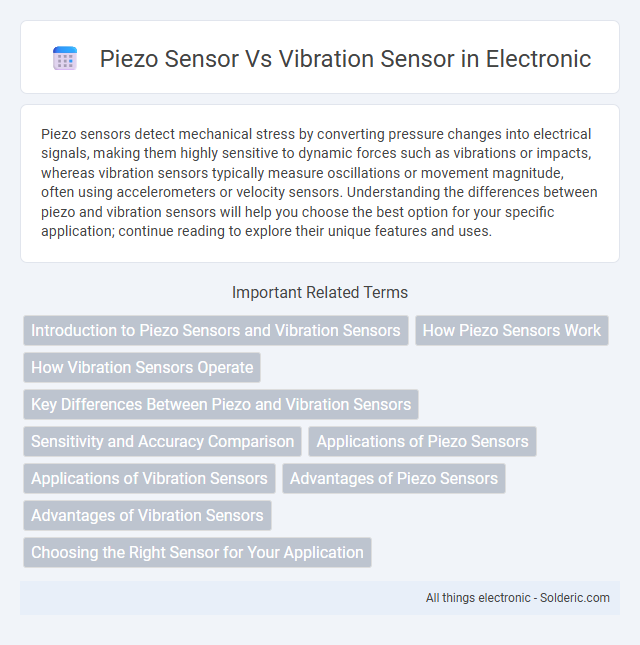Piezo sensors detect mechanical stress by converting pressure changes into electrical signals, making them highly sensitive to dynamic forces such as vibrations or impacts, whereas vibration sensors typically measure oscillations or movement magnitude, often using accelerometers or velocity sensors. Understanding the differences between piezo and vibration sensors will help you choose the best option for your specific application; continue reading to explore their unique features and uses.
Comparison Table
| Feature | Piezo Sensor | Vibration Sensor |
|---|---|---|
| Working Principle | Generates electric charge from mechanical stress | Measures mechanical vibrations or oscillations |
| Output Type | Voltage signal proportional to force | Acceleration, velocity, or displacement signal |
| Frequency Range | High frequency (up to MHz) | Wide range (Hz to kHz) |
| Sensitivity | High sensitivity to dynamic force changes | Varies by sensor type; typically moderate |
| Applications | Impact detection, pressure sensing, ultrasonics | Machine condition monitoring, structural health |
| Durability | Robust, solid-state sensor | Depends on type; can include MEMS or piezo-based |
| Power Requirement | Passive, no external power needed | Often requires external power |
| Cost | Generally low to moderate | Varies widely based on technology |
Introduction to Piezo Sensors and Vibration Sensors
Piezo sensors convert mechanical stress or pressure into electrical signals using the piezoelectric effect, making them ideal for detecting dynamic changes in force or acceleration. Vibration sensors specifically measure oscillatory motion and can utilize various technologies, including piezoelectric, accelerometer-based, or capacitive sensing methods. Both sensor types are critical in monitoring mechanical systems, but piezo sensors provide highly sensitive and fast response outputs suited for precise vibration analysis.
How Piezo Sensors Work
Piezo sensors operate by converting mechanical stress or vibrations into electrical charge through the piezoelectric effect, where certain materials generate voltage when subjected to pressure. These sensors are highly sensitive to dynamic changes such as vibrations, impacts, or acceleration, making them ideal for precise vibration measurement. Unlike general vibration sensors that may use different detection principles, piezo sensors provide accurate, fast response signals essential in industrial monitoring and structural health applications.
How Vibration Sensors Operate
Vibration sensors operate by detecting mechanical oscillations and converting them into electrical signals, often using piezoelectric materials that generate charge under stress or strain. These sensors measure frequency, amplitude, and acceleration of vibrations to monitor equipment health and structural integrity. Your choice between piezo sensors and other vibration sensors depends on the specific sensitivity, frequency range, and environmental conditions of your application.
Key Differences Between Piezo and Vibration Sensors
Piezo sensors convert mechanical stress into an electrical signal using piezoelectric materials, ideal for measuring static and dynamic pressure changes with high sensitivity and wide frequency response. Vibration sensors broadly detect oscillatory motion through various principles like piezoelectric, capacitive, or accelerometer methods, often optimized for monitoring machinery health and structural vibrations. The key difference lies in piezo sensors' focus on force or pressure detection with precise electrical output, while vibration sensors emphasize capturing motion characteristics for condition monitoring and diagnostics.
Sensitivity and Accuracy Comparison
Piezo sensors exhibit higher sensitivity compared to vibration sensors, detecting minute pressure changes due to their ability to convert mechanical stress into electrical signals with precision. Vibration sensors typically measure motion or acceleration and may have lower accuracy when capturing subtle vibrations, as their output can be influenced by environmental noise. Choosing between these sensors depends on Your application's requirement for precise measurement of dynamic forces versus general vibration monitoring.
Applications of Piezo Sensors
Piezo sensors are widely used in applications requiring precise measurement of pressure, acceleration, strain, and force, including medical devices like ultrasound imaging and industrial equipment for structural health monitoring. They excel in dynamic measurements such as detecting vibrations in machinery, automotive engine knocking, and aerospace structural integrity testing due to their high sensitivity and fast response. Unlike vibration sensors that primarily measure oscillatory motion, piezo sensors convert mechanical stress into electrical signals, enabling versatile uses in energy harvesting and acoustic devices.
Applications of Vibration Sensors
Vibration sensors are widely used in industrial machinery monitoring, automotive systems, and structural health assessments to detect early signs of equipment failure and prevent costly downtime. Unlike piezo sensors, vibration sensors can continuously monitor low-frequency oscillations and provide real-time data for predictive maintenance. Your ability to maintain operational efficiency improves significantly with the integration of vibration sensors in critical applications such as wind turbines, engines, and bridges.
Advantages of Piezo Sensors
Piezo sensors offer high sensitivity and fast response times, making them ideal for detecting minute vibrations and pressure changes with precision. Their durability and ability to operate effectively in harsh environments provide a significant advantage over traditional vibration sensors, ensuring long-lasting performance. By choosing piezo sensors, you benefit from enhanced accuracy and reliability in monitoring dynamic forces and structural health.
Advantages of Vibration Sensors
Vibration sensors offer precise monitoring of mechanical equipment by detecting a wide range of frequencies and amplitudes, enabling early fault detection and preventing costly breakdowns. These sensors provide real-time data for predictive maintenance, enhancing operational efficiency and reducing downtime. Your machinery benefits from improved reliability and extended lifespan through timely vibration analysis.
Choosing the Right Sensor for Your Application
Piezo sensors convert mechanical stress into an electrical charge, making them ideal for detecting precise pressure changes and high-frequency vibrations. Vibration sensors, often based on accelerometers, measure broader vibration patterns and are better suited for monitoring machine conditions or structural health. Your choice depends on whether you need high sensitivity and frequency response (piezo sensor) or general vibration monitoring with robust performance (vibration sensor).
piezo sensor vs vibration sensor Infographic

 solderic.com
solderic.com